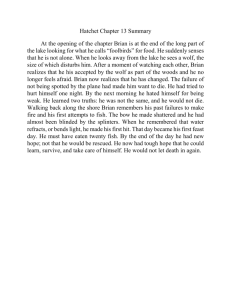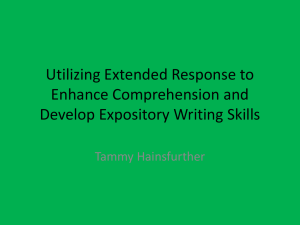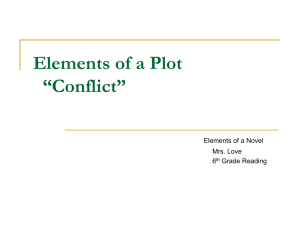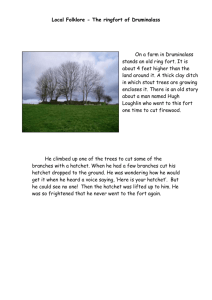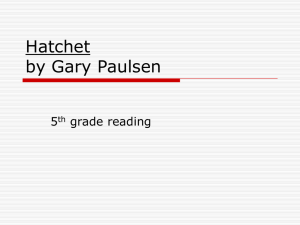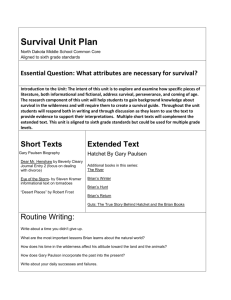7th Grade Reading Activity: Hatchet
advertisement
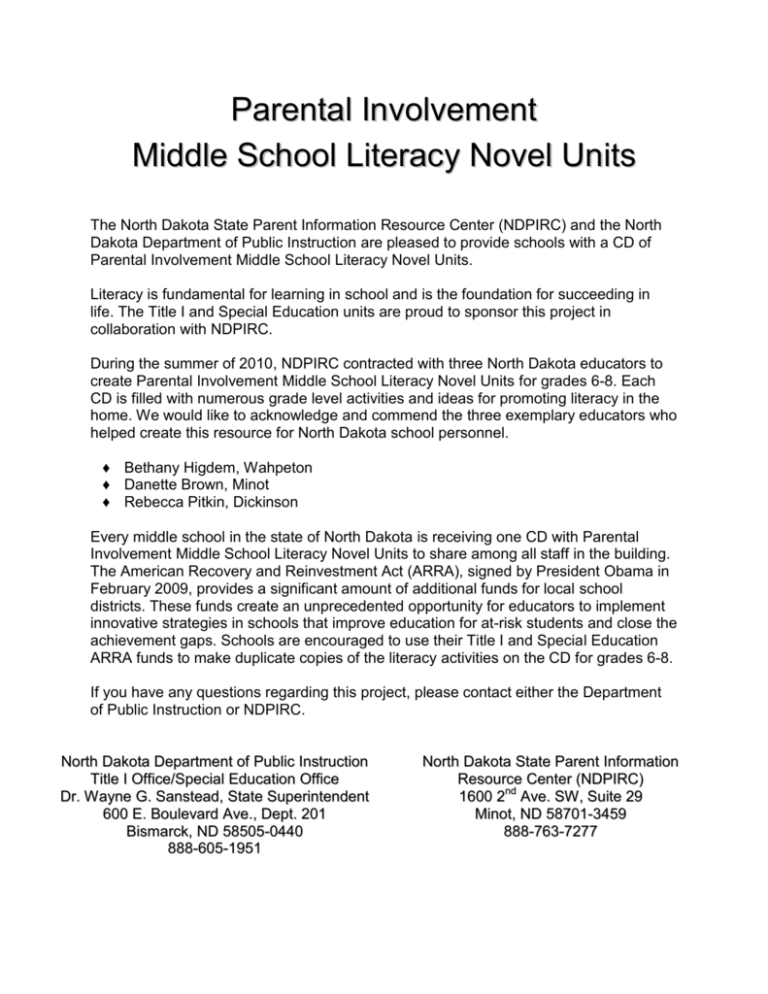
Parental Involvement Middle School Literacy Novel Units The North Dakota State Parent Information Resource Center (NDPIRC) and the North Dakota Department of Public Instruction are pleased to provide schools with a CD of Parental Involvement Middle School Literacy Novel Units. Literacy is fundamental for learning in school and is the foundation for succeeding in life. The Title I and Special Education units are proud to sponsor this project in collaboration with NDPIRC. During the summer of 2010, NDPIRC contracted with three North Dakota educators to create Parental Involvement Middle School Literacy Novel Units for grades 6-8. Each CD is filled with numerous grade level activities and ideas for promoting literacy in the home. We would like to acknowledge and commend the three exemplary educators who helped create this resource for North Dakota school personnel. ♦ Bethany Higdem, Wahpeton ♦ Danette Brown, Minot ♦ Rebecca Pitkin, Dickinson Every middle school in the state of North Dakota is receiving one CD with Parental Involvement Middle School Literacy Novel Units to share among all staff in the building. The American Recovery and Reinvestment Act (ARRA), signed by President Obama in February 2009, provides a significant amount of additional funds for local school districts. These funds create an unprecedented opportunity for educators to implement innovative strategies in schools that improve education for at-risk students and close the achievement gaps. Schools are encouraged to use their Title I and Special Education ARRA funds to make duplicate copies of the literacy activities on the CD for grades 6-8. If you have any questions regarding this project, please contact either the Department of Public Instruction or NDPIRC. North Dakota Department of Public Instruction Title I Office/Special Education Office Dr. W ayne G. Sanstead, State Superintendent 600 E. Boulevard Ave., Dept. 201 Bismarck, ND 58505-0440 888-605-1951 North Dakota State Parent Information Resource Center (NDPIRC) 1600 2nd Ave. SW , Suite 29 Minot, ND 58701-3459 888-763-7277 Title of Novel: Hatchet Title and Purpose of Activity: Going Camping Parent Engagement Strategy: The parent and child will each develop a list of five things they would bring on a camping trip in the woods and discuss their choices. Rationale for Activity: Through this activity the reader is making a meaningful connection with the main character. Making this connection aids the reader in understanding how the character feels and the motivation behind his actions. The reader becomes more engaged and actively involved as a clearer picture is formed and the reader develops questions about the text. Standards/Benchmark Targeted: 7.2.4. Use prior knowledge and experiences to aid text comprehension. 7.2.3. Generate and revise predictions to aid comprehension and understanding of the meaning of texts. Book Title: Hatchet Author: Gary Paulsen Materials: index cards, markers, pencil Directions for use: Make a list of the five things you would bring with you on a camping trip in the woods. Remember, you are only allowed five items. Draw each one of these on an index card. Show one card at a time and discuss why you chose that item. Discuss the following: Imagine you were stranded in the woods all alone with those five items, a lake, and the animals to keep you company. What dangers could you face? What would you use to protect yourself? Where would you sleep? What would you eat and how would you obtain food? Hatchet By Gary Paulsen Online Resources Trivia questions about Hatchet: http://www.funtrivia.com/playquiz/quiz152702117d018.html Online questions by chapters: http://library.thinkquest.org/J0110060/hatchet/hatchet.htm Supplemental resources: http://www.sdcoe.k12.ca.us/score/hatch/hatchettg.htm Quiz on the novel: http://www.proprofs.com/quiz-school/story.php?title=Hatchet-by-garypaulsen Title of Novel: Hatchet Title and Purpose of Activity: Power of Positive Thinking Parent Engagement Strategy: Together the parent and child will discuss good luck and bad luck occurrences throughout the novel, followed up by Brian’s reactions to the situations. Parent and child will each keep a list of personal good and bad luck experiences for the next week and discuss their outcomes. Rationale for Activity: Through this activity the reader is making a connection to the novel. This connection sets a purpose for reading and keeps the reader focused and more actively involved. Standards/Benchmark Targeted: 7.2.4. Use prior knowledge and experiences to aid text comprehension Book Title: Hatchet Author: Gary Paulsen Materials: attached sheet and pencil Directions for use: The attached sheet has two columns: good luck and bad luck. Throughout reading the novel jot down the things that happen to Brian that would be considered either good luck or bad luck. After completion of the novel read back through the list of good luck and bad luck occurrences. Discuss how Brian handled the situations and the result of those choices. For one week keep a list of good luck and bad luck situations that you have encountered. Think about how you handled the situation and the outcome it had. Discuss different ways the situations could have been handled and the possible outcomes of those choices. Note to Parents: Hatchet is a book about the survival challenges Brian faces after the plane crashes. Brian has to learn how to survive and deal with his emotions and attitude toward his situation. Brian doesn’t give up on things even though sometimes luck isn’t on his side. He learns how his attitude affects the chances of his survival. You will want to reinforce the fact that it is not really luck that matters, but the way you react to situations is what counts. Hatchet by Gary Paulsen Good Luck Bad Luck Title of Novel: Hatchet Title and Purpose of Activity: Start that Fire – Cause and Effect Parent Engagement Strategy: Together the parent and child will complete the cause and effect chart detailing Brian’s attempts to make fire. Rationale for Activity: This activity helps identify the relationship between two events: Brian’s attempts to make fire and the outcomes of those attempts. Understanding the relationship between these events assists the reader in comprehension of the text. Standards/Benchmark Targeted: 7.2.2. Use graphic organizers; summarizing; paraphrasing; and vocabulary building strategies, including context clues, to enhance understanding and aid comprehension of the meaning of texts. Book Title: Hatchet Author: Gary Paulsen Materials: attached graphic organizer, pencil Directions for use: Brian is attempting to start the fire. Fill out the cause and effect chart detailing Brian’s attempts to make fire. Discuss the following questions. Why did Brian not want to leave the fire? What are three or four ways that the fire will help Brian? Note to parent: Brian did not want to leave the fire because it was precious to him; he wanted to make sure it would not go out. The fire will help Brian cook food, keep away bugs, keep away animals, keep him warm, and keep him company. Cause and Effect Fill out the cause and effect chart showing Brian’s attempts to make fire. On the cause side, list the different things that Brian did to make the fire. On the effect side, write what happened after each of his attempts. Title of Novel: Hatchet Title and Purpose of Activity: Odd One Out Parent Engagement Strategy: Together the parent and child will decide which word does not belong in the activity Odd One Out. Rationale for Activity: Through this activity the reader will determine the meaning of new vocabulary words. Vocabulary knowledge is related to successful reading. Knowing the meaning of new vocabulary words improves the reader’s fluency and decoding skills as well as comprehension. Standards/Benchmark Targeted: 7.2.11. Use vocabulary building skills and strategies; e.g., synonyms/antonyms, prefixes/suffixes, analogies, multiple meaning words context clues, word reference aids – dictionary, glossary, thesaurus to determine the meaning of unfamiliar words and make sense of text. Book Title: Hatchet Author: Gary Paulsen Materials: attached sheet, pencil Directions for use: Using the sheet attached complete the activity Odd One Out. Look at the three words in each row and decide which word does not belong. Odd One Out Find the word that does not belong in each row across. Pleasant Sulfurous Strong smell Grimacing Frowning Smiling Push Wrenched Twisted Impaired Fixed Damaged Calm Tension Tightness Exulted Rejoiced Miserable Poor quality High quality Punky Exasperate Happiness Anger Refracts Reflects Bends light Title of Novel: Hatchet Title and Purpose of Activity: Missing Person Poster Parent Engagement Strategy: Together the parent and child will discuss what to do to help find a missing person, look at missing person posters, and make their own missing person poster of Brian. Rationale for Activity: Through this activity the reader is making a text to world connection. Making this connection sets a purpose for reading and keeps the reader focused. By doing this the readers increases their comprehension of the selection. Standards/Benchmark Targeted: 7.2.5. Read to be informed, entertained, and persuaded. Book Title: Hatchet Author: Gary Paulsen Materials: paper, colors, and internet (optional) Directions for use: After the plane crash no one knows what happens to Brian. Discuss what could be done to help find a missing person, one of those being a missing person poster. Visit a store that displays missing person posters or go to www.fbi.gov and view posters. Discuss the importance of the details that go into these posters. Create your own missing persons poster, including a picture of Brian showing the details you know about his physical appearance. Include any other details you know such as where the person was last seen. Note to Parents: Go to www.fbi.gov and click on Be Crime Smart. This contains great information about protecting your kids and learning about crime in your area. Title of Novel: Hatchet Title and Purpose of Activity: Survival Trivia Parent Engagement Strategy: Together the parent and child will play Survival Trivia. Rationale for Activity: This activity builds on previous knowledge of the reader as well as makes real world connections. Making connections is a good strategy to improve reading comprehension. Making connections forces the reader to become actively involved and engaged. Standards/Benchmark Targeted: 7.2.4. Use prior knowledge and experiences to aid text comprehension. 7.2.5. Read to be informed, entertained, and persuaded. 7.2.6. Read to develop life-long reading skills and habits. Book Title: Hatcher Author: Gary Paulsen Materials: trivia board and cards (attached), number cube, game pieces Directions for use: Cut the trivia cards apart and place them in a stack on the board. Roll the number cube, the player who rolls the highest number goes first. Player one rolls the dice. Another player reads a trivia card. If player one gets the answer correct they move forward the amount of spots shown on the number cube. If answered wrong it is now the next players turn. The first player to the finish line wins. If lost in the wilderness, what is the first thing you should do? a) Sit down and relax, collect your thoughts b) Find water c) Find shelter d) Begin yelling for help What are the two most important things you should do before you leave on a wilderness trip? a) Study the maps carefully b) Inform someone where you are going and when you plan to return c) Check the weather forecast d) Pack some extra survival meals Answer: a Answer: b, c In general what is the most important survival tool you have? a) b) c) d) Knife First aid kit Waterproof matches Fishing kit Answer: a Most lost people are rescued within 72 hours. What are the three most important priorities in a survival situation? a) b) c) d) e) Shelter Fire Water Positive thinking Food Answer: a, c, d The only equipment you have is a knife. When searching for survival food, which method is the least recommended? a) b) c) d) Fishing Trapping Hunting Finding wild edible plants How much water should the average adult drink per day? a) b) c) d) 0.5 – 1 gallon More than 2 gallons 1 – 2 galllons 1-2 quarts Answer: a Answer: c What is the best way to make sure water is pure and safely disinfected? a) b) c) d) Cool it down Chemicals Filtration Boiling If you have to spend the night outside in harsh weather, what is the first thing you should do? a) b) c) d) Check your survival kit Eat some food Start a fire Find or build a shelter Answer: d Answer: d What are three symptoms of mild hypothermia? a) b) c) d) e) Hunger Poor coordination Thirst Muddled thinking Shivering What is the best survival tip you can get? a) Use a mirror to signal for help b) Collect bird eggs as your shelter c) Make sure you always have a folding knife d) Remain calm and not to panic Answer: d Answer: b, d, e What is the most important thing if you are trying to start a fire with a flint striker? a) b) c) d) A good knife No wind The tinder must be dry and fluffed Birch as fuel A distress signal is which of the following: a) b) c) d) 4 fires in a straight line or square 3 fires in a straight line or triangle 5 fires in a straight line or circle 4 fires in a straight line or rectangle Answer: b Answer: c When making a fire for warmth, which is the best choice? a) b) c) d) Leaves Small twigs Bark Green wood To increase your chances in finding water, which of the following would be least helpful? a) b) c) d) Rock crevices Valleys and low areas Birds and insects Patches of green vegetation Answer: b Answer: d If you were in the mountains and needed to spend the night, where should you seek shelter? a) b) c) d) Close to the top In a valley On top of the mountain Somewhere in between the top and the valley SOS is the best known international distress signal, what is the code for SOS? a) b) c) d) 3 short, 3 long, 3 short 3 long, 1 short, 3 long 1 short, 3 long, 1 short 3 long, 3 short, 3 long Answer: a Answer: d Even without a compass you can find direction by using which of the following: a) b) c) d) Wind Sun Stars All of the above Answer: d In cold weather, when is it time to stop and build a fire for warmth? a) b) c) d) Your ears feel cold Your fingers are numb with cold You feel frozen It is 5:00 pm Answer: b A good tool to find water is your: a) b) c) d) Knife Compass Topographical map Survival kit Humans can survive up to five days without water. a) True b) False Answer: b Answer: c Eating snow can provide enough water to prevent your body from dehydrating. a) True b) False When encountered by a large predator the best thing to do is run away. a) True b) False Answer: b Answer: b It is a bad idea to rest near a water source. a) True b) False Answer: a If you suddenly stop shivering in the freezing cold, it is an indication that your body has adjusted to the temperatures. a) True b) False Answer: b Title of Novel: Hatchet Title and Purpose of Activity: Survival Kit Parent Engagement Strategy: Together the parent and child will complete a brainstorm web and put together a survival kit. Rationale for Activity: This activity builds on previous knowledge of the reader as well as makes real world connections. Making connections is a good strategy to improve reading comprehension. Making connections forces the reader to become actively involved and engaged. Standards/Benchmark Targeted: 7.2.4. Use prior knowledge and experiences to aid text comprehension. 7.2.2. Use graphic organizers; summarizing; paraphrasing; and vocabulary building strategies, including context clues, to enhance understanding and aid comprehension of the meaning of texts. Book Title: Hatchet Author: Gary Paulsen Materials: brainstorming web (attached), pencil, highlighter, items to put in a winter survival kit (see note to parents below) Directions for use: In Chapter 19, after the storm, the tail of the plane is visible and Brian remembers there is a survival kit on board. Use the brainstorming web to list the items that you think should be in the survival kit on the plane. Read what is found on the kit on the airplane and compare what you thought should be in the kit. Highlight the items that are in common. Discuss the items that were not found on your web and in the kit. Discuss when you would need a survival kit. One of those occasions would be if you were stranded in a winter storm. Use the brainstorming web to list items that should be included in your winter survival kit. Put a winter survival kit together. Note to Parents: The North Dakota Department of Transportation states a winter survival kit should contain the following: Several blankets and warm clothing A source of heat (such as a multiple wick candle heater and matches) Water and a metal container suitable for melting ice or snow for drinking water A radio and flashlight with extra batteries Food such as hard candy, jelly beans, raisins, nuts, candy bars, jerky Something to read to keep you awake A folding cup Toilet tissue Bright red or orange clothing and a whistle to signal help Nylon rope Cell phone Survival kit on the plane Winter survival kit Title of Novel: Hatchet Title and Purpose of Activity: Build a shelter Parent Engagement Strategy: Parent and child will work together to build a shelter as Brian did in the novel. Rationale for Activity: Through this activity the reader will build a meaningful connection with the main character. Building this connection helps the reader understand how the main character feels and the motivation behind his actions. This connection engages the reader and keeps them actively involved in the reading. Standards/Benchmark Targeted: 7.2.4. Use prior knowledge and experiences to aid text comprehension. 7.2.5. Read to be informed, entertained, and persuaded. 7.2.6. Read to develop life-long reading skills and habits Book Title: Hatchet Author: Gary Paulsen Materials: shoestring and the outdoors Directions for use: Go outdoors. Imagine you are lost in the wilderness as Brian is. The sun is about to set and you need shelter. All you have is a shoe string just as Brian did. All you can use is what you have around you. You have twenty minutes before the sun sets, build a shelter. Title of Novel: Hatchet Title and Purpose of Activity: Context Clues Parent Engagement Strategy: Together the parent and child will complete the context clues sheet. Rationale for Activity: The use of context clues can be one of the best ways to improve the reader’s reading skills. Context clues can increase the readers existing vocabulary as well as build their comprehension. Standards/Benchmark Targeted: 7.2.11. Use vocabulary building skills and strategies; e.g., synonyms/antonyms, prefixes/suffixes, analogies, multiple meaning words context clues, word reference aids – dictionary, glossary, thesaurus to determine the meaning of unfamiliar words and make sense of text. 7.2.4. Use prior knowledge and experiences to aid text comprehension. Book Title: Hatchet Author: Gary Paulsen Materials: attached sheet, pencil Directions for use: Using context clues to help select the best meaning for the vocabulary words in these chapters. Using Context Clues 1. Brian held his abdomen until the hunger cramps receded. a. Doubled b. Appeared c. Filled d. Withdrew 2. The berries tasted tart, even though he selected the ripest ones. a. Sweet b. Bland c. Sharp d. Spicy 3. Now his stomach was full, but he had some sense and didn’t gorge himself. a. Repeat b. Underestimate c. Wash d. Overfill 4. Brian couldn’t leave the quills in his leg, but just touching them made the pain more intense. a. Deep b. Wild c. Ticklish d. Quiet 5. It was a long way from sparks to fire, there had to be something for the sparks to ignite. a. Char b. Quench c. Light d. Explode Title of Novel: Hatchet Title and Purpose of Activity: Survival Collage Parent Engagement Strategy: Together the parent and child will create a collage of Brian’s survival experience to retell the novel Hatchet. Rationale for Activity: This activity focuses on retelling of the novel Hatchet. Retelling improves critical thinking skills and develops understanding of story structure. Retelling a story solidifies comprehension, connects information, improves critical thinking skills, and improves all areas of language. In order to retell a story, you must understand the story, make predictions and inferences, and relate the story to your own life experiences. Standards/Benchmark Targeted: 7.1.2. Use a variety of sources, such as computer catalogs, magazines, and newspapers, to access information. 7.2.2. Use graphic organizers; summarizing; paraphrasing; and vocabulary building strategies, including context clues, to enhance understanding and aid comprehension of the meaning of texts. 7.2.3. Generate and revise predictions to aid comprehension and understanding of the meaning of texts. 7.2.4. Use prior knowledge and experiences to aid text comprehension. Book Title: Hatcher Author: Gary Paulsen Materials: poster board, magazines, pictures, scissors, glue, markers Directions for use: Cut out, print, or draw pictures. Make a collage on the poster board about Brian’s survival experience. Use the collage to retell the story, explaining why you choose that picture for the collage. 7th Grade Supply List Bud, Not Buddy Ch 1-2: paper, pencil, internet (optional) Ch 3-5: pencil, attached sheet Ch 6-7: paper, colors Ch 8-9: Riding the Rails documentary (optional) Ch 10-11: pencil, attached sheet Ch 12-14: paper, colors Ch 15-17: paper, pencil, internet Ch 18-19: pencil, attached sheet Hatchet Before Novel: index cards, pencil, colors All Chapters: attached sheet, pencil Ch 1-3: paper, colors, and internet (optional) Ch 4-6: shoestring Ch 7-9: pencil, attached sheet Ch 10-12: pencil, attached sheet Ch 13-16: pencil, attached sheet Ch 17-18: number cube, game pieces, attaches game board and cards Ch 19: pencil, highlighter, attached sheet Post novel: poster board, magazines, glue, scissors, colors Holes Ch 1-2: paper, pencil, colors, internet Ch 3-4: note cards, paper, markers Ch 5-7: newspaper/magazines, highlighter, paper, internet (optional) Ch 8-10: paper, markers Ch 11-14: internet Ch 15-20: bingo dauber, scissors, attached bingo card Ch 21-25: peaches, 3 lbs sugar, 1 quart vinegar, cinnamon bark, water, pot, jar Ch 26-30: paper, pencil Ch 31-35: paper, markers, internet (optional) Ch 36-40: paper, pencil, attached sheet Ch 41-46: index cards, pencil Ch 47-50: pencil, markers, attached sheet Lottery Rose All chapters: pencil, attached sheet Ch 1-4: attached sheet, pencil Ch 5-9: paper, pencil Ch 10-14: paper, pencil Where the Red Fern Grows Ch 1-3: US map, attached graphic organizer, pencil, computer (optional) Ch 4-6: novel, paper, colors Ch 7-9: highlighter, pencil, attached sheet Ch 10-12: scissors, attached cards Ch 13-15: paper, pencil, internet Ch 16-18: pencil, attached sheet Ch 19-20: scissors, pencil, attached sheet


